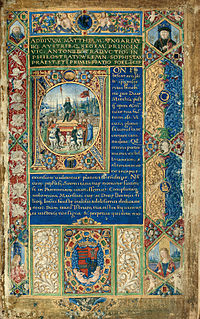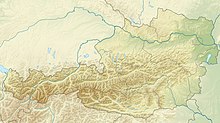
Back Obléhání Vídně (1485) Czech Bécs ostroma (1485) Hungarian Pengepungan Wina (1485) ID Assedio di Vienna (1485) Italian Опсада Беча (1485) Serbian
| Siege of Vienna | |||||||
|---|---|---|---|---|---|---|---|
| Part of the Austrian-Hungarian War (1477-1488) | |||||||
 Matthias marching into Vienna | |||||||
| |||||||
| Belligerents | |||||||
|
|
| ||||||
| Commanders and leaders | |||||||
|
Hanns von Wulfestorff[1] Caspar von Lamberg[c] Bartholomeus von Starhemberg[c] Andreas Gall[c] Ladislaus Prager[c] Alexander Schiffer[c] Tiburtius von Linzendorf[c] Leonhard Fruhmann[c] Johann Karrer[c] |
Matthias Corvinus[d] Peter Geréb de Vingard [d] Stephen Zápolya[d] Stephen V Báthory[2] Laurence of Ilok[d] | ||||||
| Units involved | |||||||
| Imperial Army | Black Army of Hungary | ||||||
| Strength | |||||||
|
2,000 foot soldiers 1,000 cavalry[3] 20,000 civilians[4] Reinforcements: 200 cavalry 300 fusiliers 60 archers[a] |
10,000 foot soldiers 18,000 cavalry[5] | ||||||
Location within Austria | |||||||
The Siege of Vienna was a decisive siege in 1485 of the Austrian–Hungarian War. It was a consequence of the ongoing conflict between Frederick III and Matthias Corvinus. After the fall of Vienna it was merged with Hungary from 1485 to 1490. Matthias Corvinus also moved his royal court to the newly occupied city. However Vienna did not become the capital of Hungary.[6]
- ^ István Diós; János Viczián (1993). "Magyar Katolikus Lexikon" [Hungarian Catholic Lexicon]. lexikon.katolikus.hu (in Hungarian). Budapest, Hungary: Szent István Társulat. Retrieved 1 July 2011.
- ^ István Draskóczy (2009). "Középkori magyar történeti kronológia a kombinált vizsga írásbeli részéhez" [Medieval Hungarian chronology for the combined written exam]. http://tortenelemszak.elte.hu - ELTE BTK Történelem Szakos Portál (in Hungarian). Budapest, Hungary: ELTE BTK - ponte.hu Kft. Archived from the original on 29 September 2011. Retrieved 1 July 2011.
{{cite web}}: External link in|work= - ^ Ignatius Aurelius Fessler (1822). Die geschichten der Ungern und ihrer landsassen [History of Hungary and its territorial changes] (in German). Leipzig, Germany: Johann Friedrich Gleditsch. p. 384. Retrieved 1 July 2011.
- ^ Johannes Sachslehner (30 June 2008). "STEP 05 – a jövőbe vezető út" [STEP 05 – road to future]. wieninternational.at/ Vienna's weekly European journal (in Hungarian). Vienna, Austria: Compress VerlagsgesmbH & Co KG. Archived from the original on 1 October 2011. Retrieved 1 July 2011.
- ^ Andrew Ayton; Leslie Price (1998). "The Military Revolution from a Medieval Perspective". The Medieval Military Revolution: State, Society and Military Change in Medieval and Early Modern Society. London, England: I.B. Tauris. ISBN 1-86064-353-1. Archived from the original on 12 November 2010. Retrieved 1 July 2011.
- ^ Gergely, Bödők; Bence, Péterfi; Attila, Pók; Klára, Sándor; Domokos, Kosáry. "Mátyás király elfoglalja Bécs városát". Rubicon (in Hungarian). Retrieved 11 March 2024.
© MMXXIII Rich X Search. We shall prevail. All rights reserved. Rich X Search

